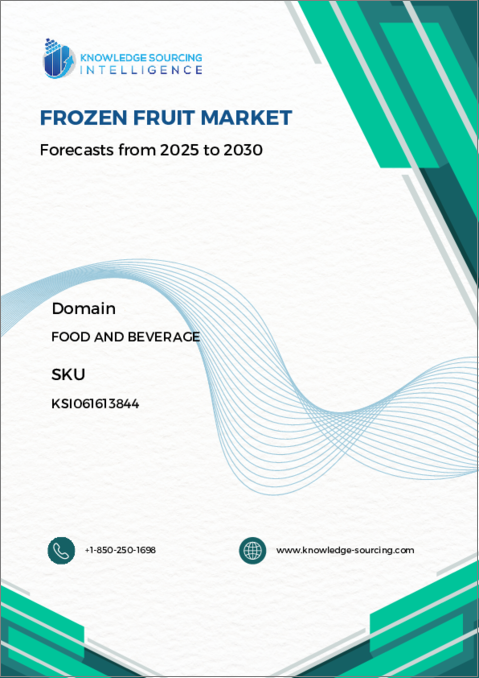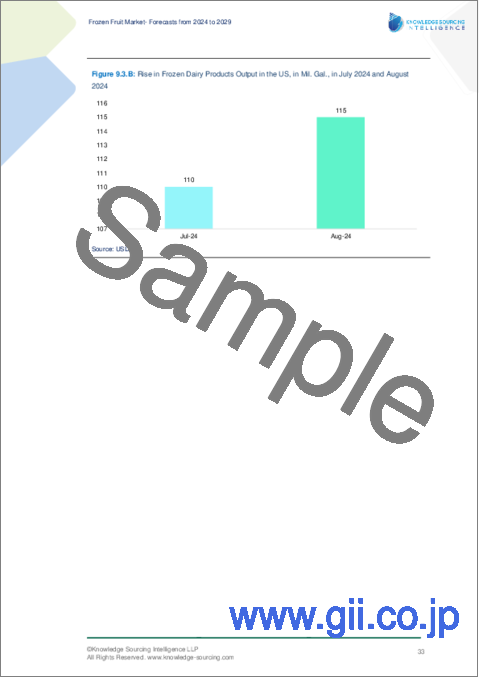|
|
市場調査レポート
商品コード
1627876
冷凍果物市場:予測(2025~2030年)Frozen Fruit Market - Forecasts from 2025 to 2030 |
||||||
カスタマイズ可能
|
|||||||
| 冷凍果物市場:予測(2025~2030年) |
|
出版日: 2024年12月16日
発行: Knowledge Sourcing Intelligence
ページ情報: 英文 144 Pages
納期: 即日から翌営業日
|
全表示
- 概要
- 目次
冷凍果物市場は、2025年の55億4,500万米ドルから2030年には77億5,800万米ドルへと、CAGR6.95%で成長すると予測されます。
冷凍果物市場の動向:
市場成長の主な要因は、その新鮮さと卓越した栄養的利点により、非季節性果物の人気が世界的に高まっていることにあります。さらに、ベーカリー製品における冷凍果物の使用量の増加が、予測期間中の市場全体の成長を牽引しています。世界中のメーカーは、冷凍果物を使用することにより、革新的な製品を製造し、ベーカリー製品の品質と保存性を高める努力をしています。冷凍果物は、ケーキ、ロールケーキ、ジャム、マフィン、タルト、ゼリーなどを含む最新のベーカリー製品に広く使用されています。
さらに、非地場産の果物に対する強い需要と、それに続く健康意識の高まりが、市場全体の成長をさらに促進すると予想されます。さらに、免疫システムを維持するために、世界中の消費者は食事に十分なタンパク質と果物を加えることに集中しており、その結果、冷凍果物の売上が増加しています。
さらに、冷凍果物の保存性の向上に関する消費者の意識の高まりが、冷凍果物の採用を促進しており、今後数年間も市場に強い影響を与えると予測されています。さらに、CBIによれば、欧州における冷凍果物の輸入量は年々大幅に増加しています。欧州における冷凍トロピカルフルーツの主要輸入国は、オランダ、ドイツ、ベルギー、ポーランド、フランス、英国で、2022年にはそれぞれ2万3,185トン、1万3,803トン、1万2,746トン、1万448トン、1万912トン、5,247トンとなっています。
世界の健康志向の高まりによる消費者の高級食品への支出意欲の高まりが、今後6年間の市場成長をさらに促進しています。世界の個人の多忙なライフスタイルの採用はストレスレベルを上昇させ、その結果、早期老化の兆候と免疫力の低下をもたらしています。そのため、予測期間中、市場関係者に繁栄の機会を提供しています。さらに、ビーガン食の採用が増加し、植物ベースの代替品に対する認識が高まっていることは、将来の健全な市場成長を促進する構えです。
冷凍果物市場の促進要因
- 冷凍果物製品の人気の高まりは、冷凍果物市場の拡大を促進すると予測されています。
市場成長を支える主な理由のひとつは、健康的なライフスタイルへの志向の高まりと冷凍果物製品の人気上昇です。世界中の消費者がライフスタイルの選択を改善し、健康的な食生活に切り替えているため、予測期間中に冷凍果物の需要が増加すると予想されます。
さらに、冷凍果物製品の人気が高まっている背景には、消費者が従来の調理の手間や時間的制約をなくし、簡単で衛生的なフルーツ製品を求めざるを得なくなった、ペースの速い現代のライフスタイルがあります。多忙なライフスタイルを送る労働人口の増加は、冷凍果物のようなすぐに食べられる食品への大きな需要を生み出し、市場全体の成長を促進すると予想されます。
さらに、非地場産果物の需要の増加も市場全体の成長に寄与しています。インターネットの普及率の上昇により、人々はさまざまな地域や国の文化的食品や生活様式に精通するようになりました。さらに、CBI外務省によると、ドイツの冷凍果物(ジュースを含む)の家庭外市場は、2021年の3万4,396トンから2022年には3万4,690トンに増加します。観光客は素晴らしい空撮画像や動画の撮影に魅了されており、消費者向けドローンの需要が今後増加する可能性を反映しています。
特定の地域で人気のある食品はほとんどありませんが、あらゆる小売チャネルを通じて入手できるようになり、健康志向の消費者の間で急速に普及しているため、世界的に人気が高まっています。消費者の間で最も人気のある冷凍果物はバナナです。熱帯・亜熱帯地域の135カ国以上で生産されています。
新鮮なバナナが大量に入手可能なため、ソフトクリーム、ミルクセーキ、チョコレートディップ、スムージー、ワッフル、マフィンなどの調理に使える冷凍バナナの需要が高まっています。例えば、リアルフローズンバナナディップインチョコレートはPukpipの人気商品です。ダークチョコレート、ミルクチョコレート、ホワイトチョコレートの3種類の味があります。家庭や商業分野での前述の調理済み料理やサービングの需要の高まりが、市場全体の成長をさらに促進すると予測されます。
冷凍果物市場の地理的要因
地域別に見ると、冷凍果物市場は北米、南米、欧州、中東・アフリカ、アジア太平洋に区分されます。北米地域では米国が最大の市場シェアを占めています。米国の冷凍果物市場は、作物需要の増加や生産要件の増加など様々な要因の影響を受けています。例えば、2021年から2022年における米国の柑橘類生産量に占めるフロリダ州のシェアは4,510万箱、同時期のオレンジ生産量は4,110万箱です。
さらに、生産者の購買決定は、イチゴやラズベリーなど特定の作物に伴う世界の価格の変動の影響を受けます。さらに、成長を可能にする農業技術開発も、国内における冷凍果物の需要を促進しています。
それに加え、収穫面積の増加は、国内の果物生産に直接影響を与えます。例えば、米国農務省によると、米国の1,000エーカー当たりの収穫面積は2020年の2億9,142万9,000エーカーから2021年には2億9,886万3,000エーカーに増加しています。
さらに、カリフォルニア州のオーガニック製品の売上高は2021年に140億米ドルとなり、2020年から16.4%増加しました。カリフォルニア州の有機栽培面積は213万エーカーを超え、これが市場に大きな影響を与えています。カリフォルニア州は米国で唯一、NOP認可の州有機プログラムを有する州です。また、過去20年間で、米国農務省(USDA)の主導による有機研究を支援するための連邦政府からの支出額は増加しています。有機農業研究・普及イニシアティブに対する強制的な資金配分は、2002年の300万米ドルから2023年には5,000万米ドルに増加しています。
さらに、米国の冷凍果物市場における製品の発売は、技術革新を促し、消費者の選択肢を広げ、ブランド間の競争を激化させ、最終的には市場の成長を押し上げ、新たな顧客を惹きつけます。市場投入が成功すれば、市場シェアが向上し、小売業者との関係が強化され、新たな市場セグメントが創出される可能性があります。例えば、2022年2月、健康的な冷凍果物バーで知られるブランドOUTSHINE(R)は、子供も大人も満足できる、同社初の保存可能でどこにでも持ち運べるスナック「フルーツ&ヨーグルトスムージーパウチ」を新発売しました。
さらに、米国を拠点とし、持続可能な植物由来の食品と飲料の未来を牽引する世界のパイオニアであるSunOpta Inc.は、カナダのケベック州を拠点とするNature's Touchに冷凍果物の一部資産を売却することを発表しました。1億4,100万米ドルと見積もられるこの取引は、当社が冷凍果物業界から撤退することを意味します。この取引には、冷凍果物事業の主要資産であるカンザス州エドワーズビルやメキシコのハコナにある施設や、かなりの量の冷凍果物の在庫が含まれます。取引は2023年10月12日に終了しました。
本レポートを購入する理由
- 洞察に満ちた分析:顧客セグメント、政府政策と社会経済要因、消費者嗜好、産業別、その他のサブセグメントに焦点を当て、主要地域だけでなく新興地域もカバーする詳細な市場考察を得ることができます。
- 競合情勢:世界の主要企業が採用している戦略的作戦を理解し、正しい戦略で市場浸透の可能性を理解することができます。
- 市場動向と促進要因:ダイナミックな要因と極めて重要な市場動向、そしてそれらが今後の市場展開をどのように形成していくかを探ります。
- 実行可能な提言:ダイナミックな環境の中で新たなビジネスストリームと収益を発掘するための戦略的決断を下すために、洞察を活用します。
- 幅広い利用者に対応:新興企業、研究機関、コンサルタント、中小企業、大企業にとって有益で費用対効果が優れています。
どのような用途で利用されていますか?
業界および市場考察、事業機会評価、製品需要予測、市場参入戦略、地理的拡大、設備投資の決定、規制の枠組みと影響、新製品開拓、競合の影響
調査範囲
- 2022年から2029年までの過去データおよび予測
- 成長機会、課題、サプライチェーンの展望、規制枠組み、顧客行動、およびトレンド分析
- 競合のポジショニング、戦略、および市場シェア分析
- 収益の成長および予測各国を含むセグメントおよび地域の分析
- 企業のプロファイリング(特に主な動向)。
冷凍果物市場は以下のセグメントに分析されます:
製品別
- ベリー類
- 柑橘類
- トロピカルフルーツ
- その他
形態別
- ホール
- キューブ
- スライス
- その他
供給源別
- 有機
- 無機
流通チャネル別
- オンライン
- オフライン
用途別
- 菓子類・ベーカリー
- 乳製品
- フルーツ系飲料
- ジャム・保存食
地域別
- 北米
- 米国
- カナダ
- メキシコ
- 南米
- ブラジル
- アルゼンチン
- その他
- 欧州
- 英国
- ドイツ
- フランス
- イタリア
- その他
- 中東・アフリカ
- サウジアラビア
- UAE
- イスラエル
- その他
- アジア太平洋
- 中国
- 日本
- インド
- 韓国
- インドネシア
- タイ
- 台湾
- その他
目次
第1章 イントロダクション
- 市場概要
- 市場の定義
- 調査範囲
- 市場セグメンテーション
- 通貨
- 前提条件
- 基準年と予測年のタイムライン
- 利害関係者にとっての主なメリット
第2章 調査手法
- 調査デザイン
- 調査プロセス
第3章 エグゼクティブサマリー
- 主な調査結果
- アナリストビュー
第4章 市場力学
- 市場促進要因
- 市場抑制要因
- ポーターのファイブフォース分析
- 業界バリューチェーン分析
第5章 冷凍果物市場:製品別
- イントロダクション
- ベリー類
- 柑橘類
- トロピカルフルーツ
- その他
第6章 冷凍果物市場:形態別
- イントロダクション
- ホール
- キューブ
- スライス
- その他
第7章 冷凍果物市場:供給源別
- イントロダクション
- 有機
- 無機
第8章 冷凍果物市場:流通チャネル別
- イントロダクション
- オンライン
- オフライン
第9章 冷凍果物市場:用途別
- イントロダクション
- 菓子類・ベーカリー
- 乳製品
- フルーツ系飲料
- ジャム・保存食
第10章 冷凍果物市場:地域別
- イントロダクション
- 北米
- 製品別
- 形態別
- 供給源別
- 流通チャネル別
- 用途別
- 国別
- 南米
- 製品別
- 形態別
- 供給源別
- 流通チャネル別
- 用途別
- 国別
- 欧州
- 製品別
- 形態別
- 供給源別
- 流通チャネル別
- 用途別
- 国別
- 中東・アフリカ
- 製品別
- 形態別
- 供給源別
- 流通チャネル別
- 用途別
- 国別
- アジア太平洋地域
- 製品別
- 形態別
- 供給源別
- 流通チャネル別
- 用途別
- 国別
第11章 競合環境と分析
- 主要企業と戦略分析
- 市場シェア分析
- 合併、買収、合意およびコラボレーション
- 競合ダッシュボード
第12章 企業プロファイル
- Val-Mex Frozen Foods, LLC
- Willamette Valley Fruit Company(Oregon Potato Company)
- Frozen Fruit Co. LLC
- De Marchi
- Dawtona Frozen
- Greenyard
- Euroberry Pty Ltd.
- Cold Alex
- Vegtal Solution
- Pitaya Foods
The frozen fruit market is expected to grow at a compound annual growth rate (CAGR) of 6.95%, from US$5.545 billion in 2025 to US$7.758 billion in 2030.
Frozen Fruit Market Trends:
The market growth is mainly attributed to the growing popularity of non-seasonal fruits globally due to their freshness and exceptional nutritional benefits. Moreover, the increasing usage of frozen fruits in bakery products is driving the overall market growth during the forecast period. Manufacturers around the world are making efforts to produce innovative products and to increase the quality and shelf life of their bakery products by using frozen fruits. Frozen fruits are widely used in modern bakery products which include cakes, rolls, jams, muffins, tarts, and jellies.
Additionally, strong demand for non-regional fruits, followed by the growing health awareness is anticipated to further drive the overall market growth. Furthermore, to maintain their immune system, consumers around the globe are concentrating on adding sufficient protein and fruits to their diet, which is resulting in increased sales of frozen fruits.
Moreover, growing consumer awareness regarding the improved shelf life of frozen fruits is promoting their adoption and is forecasted to impact the market strongly in the coming years as well. Further, as per CBI, the Europe import of frozen fruits is rising considerably every year. The leading importers of frozen tropical fruits in Europe are the Netherlands, Germany, Belgium, Poland, France, and the United Kingdom were 23,185 tonnes, 13,803 tonnes, 12,746 tonnes, 10,448 tonnes, 10,912 tonnes, and 5,247 tonnes, respectively in the year 2022.
The rising willingness of consumers to spend on premium food products due to the growing health consciousness worldwide is further enhancing the market growth over the next six years. The adoption of a busy lifestyle among individuals globally has raised stress levels, further resulting in early signs of aging and weak immunity. Hence, this is providing an opportunity for the market players to thrive during the forecast period. Furthermore, the rising adoption of a vegan diet and the rising cognizance of plant-based alternatives are poised to facilitate healthy market growth in the future.
Frozen fruit market drivers
- The growing popularity of frozen fruit products is anticipated to fuel the frozen fruit market expansion.
One of the prime reasons supporting the market growth is the growing inclination towards healthy lifestyle choices and the rising popularity of frozen fruit products. Consumers around the globe are improving their lifestyle choices and are switching toward healthy dietary habits which are expected to augment the demand for frozen fruits during the forecast period.
Moreover, the rising popularity of frozen fruit products is driven by the fast-paced modern lifestyle, which has forced consumers to look for easy and hygienic fruit products that eliminate the conventional hassles and time constraints of traditional cooking. The growing workforce population with busy lifestyles is creating a huge demand for ready-to-eat food products, such as frozen fruits, which are expected to foster overall market growth.
Additionally, increasing demand for non-regional fruits is also contributing to the overall market growth. The rising penetration of the internet has made people familiar with the cultural foods and lifestyles of different regions and countries. Moreover, the CBI Ministry of Foreign Affairs the out-of-home market of frozen fruits (including juice) in Germany shows an increase to 34,690 tonnes in the year 2022 from 34,396 tonnes in the year 2021. Tourists are attracted to capturing stunning aerial images and videos, reflecting the potential for an increase in demand for consumer drones in the years ahead.
Few food products, that are popular in a specific region, have become globally popular owing to their increased availability through all retail channels and their rapid adoption among health-conscious consumers. The most popular frozen fruit among consumers is the banana. It is produced in over 135 countries across tropical and subtropical regions.
The large availability of fresh bananas has increased the demand for frozen bananas, which can be used for the preparation of soft serve, milkshakes, chocolate-dipped frozen bananas, smoothies, waffles, and muffins. For instance, Real Frozen Bananas Dipped in Chocolate is a popular product by Pukpip. They are available in three different flavors that are dark chocolate, milk chocolate, and white chocolate. Growing demand for the aforementioned prepared dishes or servings in the household and commercial sectors is further projected to drive the overall market growth.
Frozen fruit market geographical
Based on geography, the frozen fruit market is segmented into North America, South America, Europe, the Middle East and Africa, and the Asia Pacific. The United States held the largest market share in the North American region. The frozen fruit market in the United States is affected by various factors such as increasing crop demand and production requirements. For instance, Florida's share of U.S. citrus output in 2021-2022 is 45.1 million boxes and orange production of 41.1 million boxes in the same timeframe.
In addition, the frozen fruit purchasing decisions of producers are affected by the fluctuations in the global prices that accompany specific crops, including strawberries and raspberries. Furthermore, the growth-enabling agricultural technological developments are also fueling the demand for frozen fruits in the nation.
Besides that, the increasing crop area harvested directly impacts the production of fruits in the nation. For instance, according to USDA, crop area harvested per 1,000 acres in the United States increased from 2,91,429 thousand acres in 2020 to 2,98,863 thousand acres in 2021.
Moreover, California organic product sales were $14.0 billion in 2021, up 16.4 percent from 2020. Organic cultivation covers more than 2.13 million acres in the state which in turn largely impacts the market. California is the only state in the United States to have a NOP-approved state organic program. Also, over the last two decades, authorized federal expenditures to assist organic research through USDA initiatives have risen. The mandatory funding allocation for the Organic Agriculture Research and Extension Initiative has increased from $3 million in 2002 to $50 million in 2023.
In addition, Product launches in the US frozen fruits market spur innovation, broaden consumer options, and increase brand rivalry, eventually boosting market growth and attracting new customers. Successful launches may improve market share, strengthen retailer relationships, and create new market segments, all while boosting total sales and industry progress. For instance, in February 2022, OUTSHINE(R), a brand known for its wholesome frozen fruit bars, introduced new Fruit & Yoghurt Smoothie Pouches, the company's first shelf-stable, take-anywhere snack to help satisfy both kids and adults.
Additionally, SunOpta Inc., a U.S.-based worldwide pioneer driving the future of sustainable, plant-based foods and drinks, announced the sale of certain frozen fruit assets to Nature's Touch, a Quebec, Canada-based firm. The deal, estimated at $141 million, marks the Company's withdrawal from the frozen fruit industry. The transaction includes the frozen fruit business's key assets, such as facilities in Edwardsville, Kansas, and Jacona, Mexico, as well as a considerable amount of frozen fruit inventory. The deal ended on October 12, 2023.
Reasons for buying this report:-
- Insightful Analysis: Gain detailed market insights covering major as well as emerging geographical regions, focusing on customer segments, government policies and socio-economic factors, consumer preferences, industry verticals, other sub- segments.
- Competitive Landscape: Understand the strategic maneuvers employed by key players globally to understand possible market penetration with the correct strategy.
- Market Drivers & Future Trends: Explore the dynamic factors and pivotal market trends and how they will shape up future market developments.
- Actionable Recommendations: Utilize the insights to exercise strategic decision to uncover new business streams and revenues in a dynamic environment.
- Caters to a Wide Audience: Beneficial and cost-effective for startups, research institutions, consultants, SMEs, and large enterprises.
What do businesses use our reports for?
Industry and Market Insights, Opportunity Assessment, Product Demand Forecasting, Market Entry Strategy, Geographical Expansion, Capital Investment Decisions, Regulatory Framework & Implications, New Product Development, Competitive Intelligence
Report Coverage:
- Historical data & forecasts from 2022 to 2029
- Growth Opportunities, Challenges, Supply Chain Outlook, Regulatory Framework, Customer Behaviour, and Trend Analysis
- Competitive Positioning, Strategies, and Market Share Analysis
- Revenue Growth and Forecast Assessment of segments and regions including countries
- Company Profiling (Strategies, Products, Financial Information, and Key Developments among others)
The frozen fruit market is analyzed into the following segments:
By Product
- Berries
- Citrus Fruits
- Tropical Fruits
- Others
By Form
- Whole
- Cubed
- Sliced
- Others
By Source
- Organic
- Inorganic
By Distribution Channel
- Online
- Offline
By Application
- Confectionery and Bakery
- Dairy Products
- Fruit Based Beverages
- Jams & Preserves
By Geography
- North America
- United States
- Canada
- Mexico
- South America
- Brazil
- Argentina
- Others
- Europe
- United Kingdom
- Germany
- France
- Italy
- Others
- Middle East and Africa
- Saudi Arabia
- UAE
- Israel
- Others
- Asia Pacific
- China
- Japan
- India
- South Korea
- Indonesia
- Thailand
- Taiwan
- Others
TABLE OF CONTENTS
1. INTRODUCTION
- 1.1. Market Overview
- 1.2. Market Definition
- 1.3. Scope of the Study
- 1.4. Market Segmentation
- 1.5. Currency
- 1.6. Assumptions
- 1.7. Base and Forecast Years Timeline
- 1.8. Key benefits for the stakeholders
2. RESEARCH METHODOLOGY
- 2.1. Research Design
- 2.2. Research Process
3. EXECUTIVE SUMMARY
- 3.1. Key Findings
- 3.2. Analyst View
4. MARKET DYNAMICS
- 4.1. Market Drivers
- 4.2. Market Restraints
- 4.3. Porter's Five Forces Analysis
- 4.3.1. Bargaining Power of Suppliers
- 4.3.2. Bargaining Power of Buyers
- 4.3.3. Threat of New Entrants
- 4.3.4. Threat of Substitutes
- 4.3.5. Competitive Rivalry in the Industry
- 4.4. Industry Value Chain Analysis
5. FROZEN FRUIT MARKET BY PRODUCT
- 5.1. Introduction
- 5.2. Berries
- 5.3. Citrus Fruits
- 5.4. Tropical Fruits
- 5.5. Others
6. FROZEN FRUIT MARKET BY FORM
- 6.1. Introduction
- 6.2. Whole
- 6.3. Cubed
- 6.4. Sliced
- 6.5. Others
7. FROZEN FRUIT MARKET BY SOURCE
- 7.1. Introduction
- 7.2. Organic
- 7.3. Inorganic
8. FROZEN FRUIT MARKET BY DISTRIBUTION CHANNEL
- 8.1. Introduction
- 8.2. Online
- 8.3. Offline
9. FROZEN FRUIT MARKET BY APPLICATION
- 9.1. Introduction
- 9.2. Confectionery and Bakery
- 9.3. Dairy Products
- 9.4. Fruit Based Beverages
- 9.5. Jams & Preserves
10. FROZEN FRUIT MARKET BY GEOGRAPHY
- 10.1. Introduction
- 10.2. North America
- 10.2.1. By Product
- 10.2.2. By Form
- 10.2.3. By Source
- 10.2.4. By Distribution Channel
- 10.2.5. By Application
- 10.2.6. By Country
- 10.2.6.1. United States
- 10.2.6.2. Canada
- 10.2.6.3. Mexico
- 10.3. South America
- 10.3.1. By Product
- 10.3.2. By Form
- 10.3.3. By Source
- 10.3.4. By Distribution Channel
- 10.3.5. By Application
- 10.3.6. By Country
- 10.3.6.1. Brazil
- 10.3.6.2. Argentina
- 10.3.6.3. Others
- 10.4. Europe
- 10.4.1. By Product
- 10.4.2. By Form
- 10.4.3. By Source
- 10.4.4. By Distribution Channel
- 10.4.5. By Application
- 10.4.6. By Country
- 10.4.6.1. United Kingdom
- 10.4.6.2. Germany
- 10.4.6.3. France
- 10.4.6.4. Italy
- 10.4.6.5. Others
- 10.5. Middle East and Africa
- 10.5.1. By Product
- 10.5.2. By Form
- 10.5.3. By Source
- 10.5.4. By Distribution Channel
- 10.5.5. By Application
- 10.5.6. By Country
- 10.5.6.1. Saudi Arabia
- 10.5.6.2. UAE
- 10.5.6.3. Others
- 10.6. Asia Pacific
- 10.6.1. By Product
- 10.6.2. By Form
- 10.6.3. By Source
- 10.6.4. By Distribution Channel
- 10.6.5. By Application
- 10.6.6. By Country
- 10.6.6.1. China
- 10.6.6.2. Japan
- 10.6.6.3. India
- 10.6.6.4. South Korea
- 10.6.6.5. Indonesia
- 10.6.6.6. Thailand
- 10.6.6.7. Taiwan
- 10.6.6.8. Others
11. COMPETITIVE ENVIRONMENT AND ANALYSIS
- 11.1. Major Players and Strategy Analysis
- 11.2. Market Share Analysis
- 11.3. Mergers, Acquisitions, Agreements, and Collaborations
- 11.4. Competitive Dashboard
12. COMPANY PROFILES
- 12.1. Val-Mex Frozen Foods, LLC
- 12.2. Willamette Valley Fruit Company (Oregon Potato Company)
- 12.3. Frozen Fruit Co. LLC
- 12.4. De Marchi
- 12.5. Dawtona Frozen
- 12.6. Greenyard
- 12.7. Euroberry Pty Ltd.
- 12.8. Cold Alex
- 12.9. Vegtal Solution
- 12.10. Pitaya Foods





